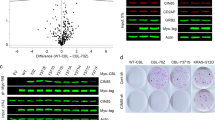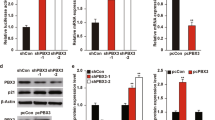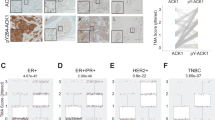Abstract
Multiple growth pathways lead to enhanced proliferation in malignant cells. However, how the core machinery of DNA replication is regulated by growth signaling remains largely unclear. The sliding clamp proliferating cell nuclear antigen (PCNA) is an indispensable component of the DNA machinery responsible for replicating the genome and maintaining genomic integrity. We previously reported that epidermal growth factor receptor (EGFR) triggered tyrosine 211 (Y211) phosphorylation of PCNA, which in turn stabilized PCNA on chromatin to promote cell proliferation. Here we show that the phosphorylation can also be catalyzed by the non-receptor tyrosine kinase c-Abl. We further demonstrate that, in the absence of EGFR, signaling to PCNA can be attained through the activation of the Ron receptor tyrosine kinase and the downstream non-receptor tyrosine kinase c-Abl. We show that Ron and c-Abl form a complex, and that activation of Ron by its ligand, hepatocyte growth factor-like protein (HGFL), stimulates c-Abl kinase activity, which in turn directly phosphorylates PCNA at Y211 and leads to an increased level of chromatin-associated PCNA. Correspondingly, HGFL-induced Ron activation resulted in Y211 phosphorylation of PCNA while silencing of c-Abl blocked this effect. We show that c-Abl and Y211 phosphorylation of PCNA is an important axis downstream of Ron, which is required for cell proliferation. Treatment with a specific peptide that inhibits Y211 phosphorylation of PCNA or with the c-Abl pharmacological inhibitor imatinib suppressed HGFL-induced cell proliferation. Our findings identify the pathway of Ron-c-Abl-PCNA as a mechanism of oncogene-induced cell proliferation, with potentially important implications for development of combination therapy of breast cancer.
This is a preview of subscription content, access via your institution
Access options
Subscribe to this journal
Receive 50 print issues and online access
$259.00 per year
only $5.18 per issue
Buy this article
- Purchase on Springer Link
- Instant access to full article PDF
Prices may be subject to local taxes which are calculated during checkout








Similar content being viewed by others

References
Moldovan GL, Pfander B, Jentsch S . PCNA, the maestro of the replication fork. Cell 2007; 129: 665–679.
Ayyagari R, Impellizzeri KJ, Yoder BL, Gary SL, Burgers PM . A mutational analysis of the yeast proliferating cell nuclear antigen indicates distinct roles in DNA replication and DNA repair. Mol Cell Biol 1995; 15: 4420–4429.
Lehmann AR . Translesion synthesis in mammalian cells. Exp Cell Res 2006; 312: 2673–2676.
Essers J, Theil AF, Baldeyron C, van Cappellen WA, Houtsmuller AB, Kanaar R et al. Nuclear dynamics of PCNA in DNA replication and repair. Mol Cell Biol 2005; 25: 9350–9359.
Ulrich HD . How to activate a damage-tolerant polymerase: consequences of PCNA modifications by ubiquitin and SUMO. Cell Cycle 2004; 3: 15–18.
Maga G, Hubscher U . Proliferating cell nuclear antigen (PCNA): a dancer with many partners. J Cell Sci 2003; 116: 3051–3060.
Matunis MJ . On the road to repair: PCNA encounters SUMO and ubiquitin modifications. Mol Cell 2002; 10: 441–442.
Marti TM, Kunz C, Fleck O . DNA mismatch repair and mutation avoidance pathways. J Cell Physiol 2002; 191: 28–41.
Paunesku T, Mittal S, Protic M, Oryhon J, Korolev SV, Joachimiak A et al. Proliferating cell nuclear antigen (PCNA): ringmaster of the genome. Int J Radiat Biol 2001; 77: 1007–1021.
Kelman Z . PCNA: structure, functions and interactions. Oncogene 1997; 14: 629–640.
Komatsu K, Wharton W, Hang H, Wu C, Singh S, Lieberman HB et al. PCNA interacts with hHus1/hRad9 in response to DNA damage and replication inhibition. Oncogene 2000; 19: 5291–5297.
Wang S-C, Nakajima Y, Yu Y-L, Xia W, Chen C-T, Yang C-C et al. Tyrosine phosphorylation controls PCNA function through protein stability. Nat Cell Biol 2006; 8: 1359–1368.
Zhao H, Ho P-C, Lo Y-H, Espejo A, Bedford MT, Hung M-C et al. Interaction of proliferation cell nuclear antigen (PCNA) with c-Abl in cell proliferation and response to DNA damages in breast cancer. PLoS One 2012; 7: e29416.
Taagepera S, McDonald D, Loeb JE, Whitaker LL, McElroy AK, Wang JY et al. Nuclear-cytoplasmic shuttling of c-ABL tyrosine kinase. Proc Natl Acad Sci USA 1998; 95: 7457–7462.
Baker MA, Hetherington L, Curry B, Aitken RJ . Phosphorylation and consequent stimulation of the tyrosine kinase c-Abl by PKA in mouse spermatozoa; its implications during capacitation. Dev Biol 2009; 333: 57–66.
Barila D, Mangano R, Gonfloni S, Kretzschmar J, Moro M, Bohmann D et al. A nuclear tyrosine phosphorylation circuit: c-Jun as an activator and substrate of c-Abl and JNK. EMBO J 2000; 19: 273–281.
Baskaran R, Escobar SR, Wang JYJ . Nuclear c-Abl Is a COOH-terminal repeated domain (CTD)-tyrosine kinase-specific for the mammalian RNA polymerase II: possible role in transcription elongation. Cell Growth Differ 1999; 10: 387–396.
Stuart JR, Gonzalez FH, Kawai H, Yuan Z-M . c-Abl interacts with the WAVE2 signaling complex to induce membrane ruffling and cell spreading. J Biol Chem 2006; 281: 31290–31297.
Woodring PJ, Hunter T, Wang JYJ . Regulation of F-actin-dependent processes by the Abl family of tyrosine kinases. J Cell Sci 2003; 116: 2613–2626.
Baskaran R, Wood LD, Whitaker LL, Canman CE, Morgan SE, Xu Y et al. Ataxia telangiectasia mutant protein activates c-Abl tyrosine kinase in response to ionizing radiation. Nature 1997; 387: 516–519.
Gong J, Costanzo A, Yang H-Q, Melino G, Kaelin WG, Levrero M et al. The tyrosine kinase c-Abl regulates p73 in apoptotic response to cisplatin-induced DNA damage. Nature 1999; 399: 806–809.
Kharbanda S, Yuan ZM, Weichselbaum R, Kufe D . Determination of cell fate by c-Abl activation in the response to DNA damage. Oncogene 1998; 17: 3309–3318.
Kim WJ, Rajasekaran B, Brown KD . MLH1- and ATM-dependent MAPK signaling is activated through c-Abl in response to the alkylator N-methyl-N'-nitro-N'-nitrosoguanidine. J Biol Chem 2007; 282: 32021–32031.
Leong CO, Vidnovic N, DeYoung MP, Sgroi D, Ellisen LW . The p63/p73 network mediates chemosensitivity to cisplatin in a biologically defined subset of primary breast cancers. J Clin Invest 2007; 117: 1370–1380.
Levav-Cohen Y, Goldberg Z, Zuckerman V, Grossman T, Haupt S, Haupt Y . c-Abl as a modulator of p53. Biochem Biophy Res Comm 2005; 331: 737–749.
Mantovani F, Piazza S, Gostissa M, Strano S, Zacchi P, Mantovani R et al. Pin1 links the activities of c-Abl and p300 in regulating p73 function. Mol Cell 2004; 14: 625–636.
Nehme A, Baskaran R, Aebi S, Fink D, Nebel S, Cenni B et al. Differential induction of c-Jun NH2-terminal kinase and c-Abl kinase in DNA mismatch repair-proficient and -deficient cells exposed to cisplatin. Cancer Res 1997; 57: 3253–3257.
Shafman T, Khanna KK, Kedar P, Spring K, Kozlov S, Yen T et al. Interaction between ATM protein and c-Abl in response to DNA damage. Nature 1997; 387: 520–523.
Shaul Y, Ben-Yehoyada M . Role of c-Abl in the DNA damage stress response. Cell Res 2005; 15: 33–35.
Truong T, Sun G, Doorly M, Wang JYJ, Schwartz MA . Modulation of DNA damage-induced apoptosis by cell adhesion is independently mediated by p53 and c-Abl. Proc Natl Acad ScUSA 2003; 100: 10281–10286.
Tsai KKC, Yuan Z-M . c-Abl stabilizes p73 by a phosphorylation-augmented Interaction. Cancer Res 2003; 63: 3418–3424.
Yi W, Lee T-H, Tompkins JD, Zhu F, Wu X, Her C . Physical and functional Interaction between hMSH5 and c-Abl. Cancer Res 2006; 66: 151–158.
Yoshida K, Yamaguchi T, Natsume T, Kufe D, Miki Y . JNK phosphorylation of 14-3-3 proteins regulates nuclear targeting of c-Abl in the apoptotic response to DNA damage. Nat Cell Biol 2005; 7: 278–285.
Yuan Z-M, Huang Y, Ishiko T, Kharbanda S, Weichselbaum R, Kufe D . Regulation of DNA damage-induced apoptosis by the c-Abl tyrosine kinase. Proc Natl Acad Sci USA 1997; 94: 1437–1440.
Yuan Z-M, Huang Y, Whang Y, Sawyers C, Weichselbaum R, Kharbanda S et al. Role for c-Abl tyrosine kinase in growth arrest response to DNA damage. Nature 1996; 382: 272–274.
Yuan Z-M, Shioya H, Ishiko T, Sun X, Gu J, Huang Y et al. p73 is regulated by tyrosine kinase c-Abl in the apoptotic response to DNA damage. Nature 1999; 399: 814–817.
Wang JY, Ki SW . Choosing between growth arrest and apoptosis through the retinoblastoma tumour suppressor protein, Abl and p73. Biochem Soc Trans 2001; 29: 666–673.
Agami R, Blandino G, Oren M, Shaul Y . Interaction of c-Abl and p73alpha and their collaboration to induce apoptosis. Nature 1999; 399: 809–813.
Yogalingam G, Pendergast AM . Abl kinases regulate autophagy by promoting the trafficking and function of lysosomal components. J Biol Chem 2008; 283: 35941–35953.
Srinivasan D, Plattner R . Activation of Abl tyrosine kinases promotes invasion of aggressive breast cancer cells. Cancer Res 2006; 66: 5648–5655.
Srinivasan D, Sims JT, Plattner R . Aggressive breast cancer cells are dependent on activated Abl kinases for proliferation, anchorage-independent growth and survival. Oncogene 2008; 27: 1095–1105.
Sirvent A, Boureux A, Simon V, Leroy C, Roche S . The tyrosine kinase Abl is required for Src-transforming activity in mouse fibroblasts and human breast cancer cells. Oncogene 2007; 26: 7313–7323.
Zhao H, Lo Y-H, Yu L, Wang S-C . Overcoming resistance to fulvestrant (ICI182,780) by downregulating the c-ABL proto-oncogene in breast cancer. Mol Carcinog 2011; 50: 383–389.
Zhao H, Ou-Yang F, Chen IF, Hou MF, Yuan SS, Chang HL et al. Enhanced resistance to tamoxifen by the c-ABL proto-oncogene in breast cancer. Neoplasia 2010; 12: 214–223.
Lin J, Arlinghaus R . Activated c-Abl tyrosine kinase in malignant solid tumors. Oncogene 2008; 27: 4385–4391.
Lin J, Sun T, Ji L, Deng W, Roth J, Minna J et al. Oncogenic activation of c-Abl in non-small cell lung cancer cells lacking FUS1 expression: inhibition of c-Abl by the tumor suppressor gene product Fus1. Oncogene 2007; 26: 6989–6996.
Srinivasan D, Kaetzel DM, Plattner R . Reciprocal regulation of Abl and receptor tyrosine kinases. Cell Signal 2009; 21: 1143–1150.
Tanos B, Pendergast AM . Abl tyrosine kinase regulates endocytosis of the epidermal growth factor receptor. J Biol Chem 2006; 281: 32714–32723.
Wagh PK, Peace BE, Waltz SE . Met-related receptor tyrosine kinase Ron in tumor growth and metastasis. In: George F Vande Woude, George Klein (eds). Advances in Cancer Research. Academic Press, New York, 2008, pp 1–33.
Iwama A, Yamaguchi N, Suda T . STK/RON receptor tyrosine kinase mediates both apoptotic and growth signals via the multifunctional docking site conserved among the HGF receptor family. EMBO J 1996; 15: 5866–5875.
Follenzi A, Bakovic S, Gual P, Stella MC, Longati P, Comoglio PM . Cross-talk between the proto-oncogenes Met and Ron. Oncogene 2000; 19: 3041–3049.
Peace BE, Hughes MJ, Degen SJ, Waltz SE . Point mutations and overexpression of Ron induce transformation, tumor formation, and metastasis. Oncogene 2001; 20: 6142–6151.
Zinser GM, Leonis MA, Toney K, Pathrose P, Thobe M, Kader SA et al. Mammary-specific Ron receptor overexpression induces highly metastatic mammary tumors associated with β-catenin activation.. Cancer Res 2006; 66: 11967–11974.
Peace BE, Toney-Earley K, Collins MH, Waltz SE . Ron receptor signaling augments mammary tumor formation and metastasis in a murine model of breast cancer. Cancer Res 2005; 65: 1285–1293.
Welm AL, Sneddon JB, Taylor C, Nuyten DSA, van de Vijver MJ, Hasegawa BH et al. The macrophage-stimulating protein pathway promotes metastasis in a mouse model for breast cancer and predicts poor prognosis in humans. Proc Natl Acad Sci USA 2007; 104: 7570–7575.
Leonis MA, Thobe MN, Waltz SE . Ron-receptor tyrosine kinase in tumorigenesis and metastasis. Future Oncol 2007; 3: 441–448.
Lee W-Y, Chen HHW, Chow N-H, Su W-C, Lin P-W, Guo H-R . Prognostic significance of co-expression of RON and MET receptors in node-negative breast cancer patients. Clin Cancer Res 2005; 11: 2222–2228.
Maggiora P, Marchio S, Stella MC, Giai M, Belfiore A, De Bortoli M et al. Overexpression of the RON gene in human breast carcinoma. Oncogene 1998; 16: 2927–2933.
O'Toole JM, Rabenau KE, Burns K, Lu D, Mangalampalli V, Balderes P et al. Therapeutic implications of a human neutralizing antibody to the macrophage-stimulating protein receptor tyrosine kinase (RON), a c-MET family member. Cancer Res 2006; 66: 9162–9170.
Andoniou CE, Thien CB, Langdon WY . The two major sites of cbl tyrosine phosphorylation in abl-transformed cells select the crkL SH2 domain. Oncogene 1996; 12: 1981–1989.
Koleske AJ, Gifford AM, Scott ML, Nee M, Bronson RT, Miczek KA et al. Essential roles for the Abl and Arg tyrosine kinases in neurulation. Neuron 1998; 21: 1259–1272.
Plattner R, Irvin BJ, Guo S, Blackburn K, Kazlauskas A, Abraham RT et al. A new link between the c-Abl tyrosine kinase and phosphoinositide signalling through PLC-gamma1. Nat Cell Biol 2003; 5: 309–319.
McClaine RJ, Marshall AM, Wagh PK, Waltz S . Ron receptor tyrosine kinase activation confers resistance to tamoxifen in breast cacner cell lines. Neoplasia 2010; 12: 650–658.
Zhao H, Lo Y-H, Ma L, Waltz SE, Gray JK, Hung M-C et al. Targeting tyrosine phosphorylation of PCNA inhibits prostate cancer growth. Mol Cancer Ther 2011; 10: 29–36.
Thobe MN, Gurusamy D, Pathrose P, Waltz SE . The Ron receptor tyrosine kinase positively regulates angiogenic chemokine production in prostate cancer cells. Oncogene 2010; 29: 214–226.
Duyster J, Baskaran R, Wang JY . Src homology 2 domain as a specificity determinant in the c-Abl-mediated tyrosine phosphorylation of the RNA polymerase II carboxyl-terminal repeated domain. Proc Natl Acad Sci USA 1995; 92: 1555–1559.
Jones RB, Gordus A, Krall JA, MacBeath G . A quantitative protein interaction network for the ErbB receptors using protein microarrays. Nature 2006; 439: 168–174.
Plattner R, Kadlec L, DeMali KA, Kazlauskas A, Pendergast AM . c-Abl is activated by growth factors and Src family kinases and has a role in the cellular response to PDGF. Genes Dev 1999; 13: 2400–2411.
Mendelsohn J, Baselga J . Status of epidermal growth factor receptor antagonists in the biology and treatment of cancer. J Clin Oncol 2003; 21: 2787–2799.
Lo YH, Ho PC, Zhao H, Wang SC . Inhibition of c-ABL sensitizes breast cancer cells to the dual ErbB receptor tyrosine kinase inhibitor lapatinib (GW572016). Anticancer Res 2011; 31: 789–795.
Furukawa T, Kubota T, Suto A, Takahara T, Yamaguchi H, Takeuchi T et al. Clinical usefulness of chemosensitivity testing using the MTT assay. J Surg Oncol 1991; 48: 188–193.
Plattner R, Koleske AJ, Kazlauskas A, Pendergast AM . Bidirectional signaling links the Abelson kinases to the platelet-derived growth factor receptor. Mol Cell Biol 2004; 24: 2573–2583.
Acknowledgements
We thank Drs David Plas and Daniel Starczynowski for the help in discussion and reagents. We also like to thank Dr Belinda Peace and Glenn Doerman for assistance in editing the manuscript and preparing the graphics, and Jerylin Gray for technical assistance. This work was supported in part by the Susan G Komen Breast Cancer Research Award KG080540, the Department of Defense Prostate Cancer Research Program New Investigator Award PC073951, the Center for Clinical and Translational Science and Training (CCTST) of University of Cincinnati and Cincinnati Children’s Hospital, and the Elsa Pardee Foundation (S-CW), the VA Merit Award 1001BX000803 and R01 CA125379 (SEW), and R01 CA116784 (RP). This project was also supported in part by PHS Grant P30 DK078392.
Author information
Authors and Affiliations
Corresponding author
Ethics declarations
Competing interests
The authors declare no conflict of interest.
Additional information
Supplementary Information accompanies this paper on the Oncogene website
Supplementary information
Rights and permissions
About this article
Cite this article
Zhao, H., Chen, MS., Lo, YH. et al. The Ron receptor tyrosine kinase activates c-Abl to promote cell proliferation through tyrosine phosphorylation of PCNA in breast cancer. Oncogene 33, 1429–1437 (2014). https://doi.org/10.1038/onc.2013.84
Received:
Revised:
Accepted:
Published:
Issue Date:
DOI: https://doi.org/10.1038/onc.2013.84
Keywords
This article is cited by
-
A network map of macrophage-stimulating protein (MSP) signaling
Journal of Cell Communication and Signaling (2023)
-
MiR-216a-5p targets TCTN1 to inhibit cell proliferation and induce apoptosis in esophageal squamous cell carcinoma
Cellular & Molecular Biology Letters (2019)
-
Phosphoproteome profiling revealed abnormally phosphorylated AMPK and ATF2 involved in glucose metabolism and tumorigenesis of GH-PAs
Journal of Endocrinological Investigation (2019)
-
Enabling Tumor Growth and Progression: Recent Progress in Unraveling the Functions of ABL Kinases in Solid Tumor Cells
Current Pharmacology Reports (2018)
-
Biological evaluation of antibody-maytansinoid conjugates as a strategy of RON targeted drug delivery for treatment of non-small cell lung cancer
Journal of Experimental & Clinical Cancer Research (2016)


